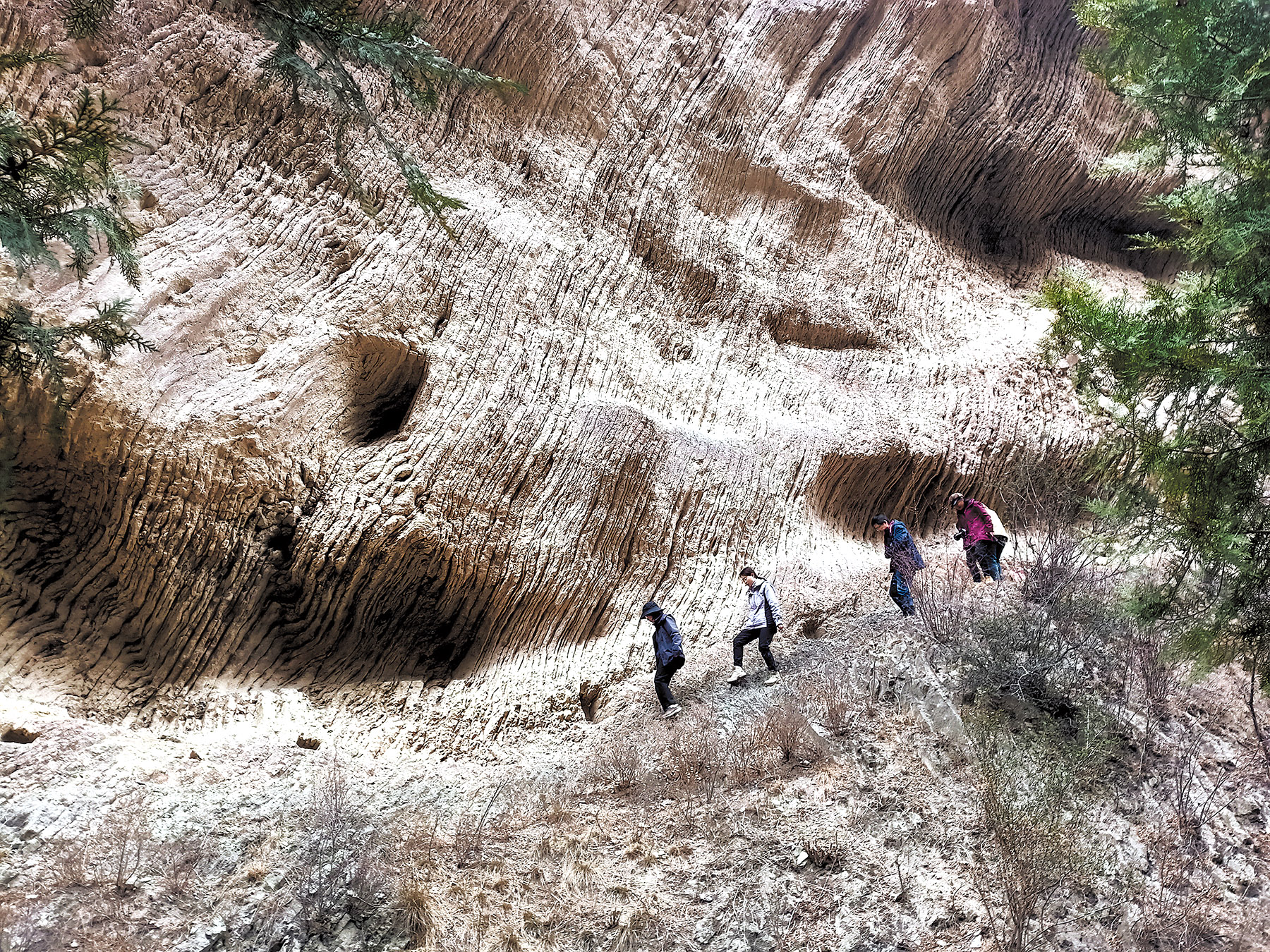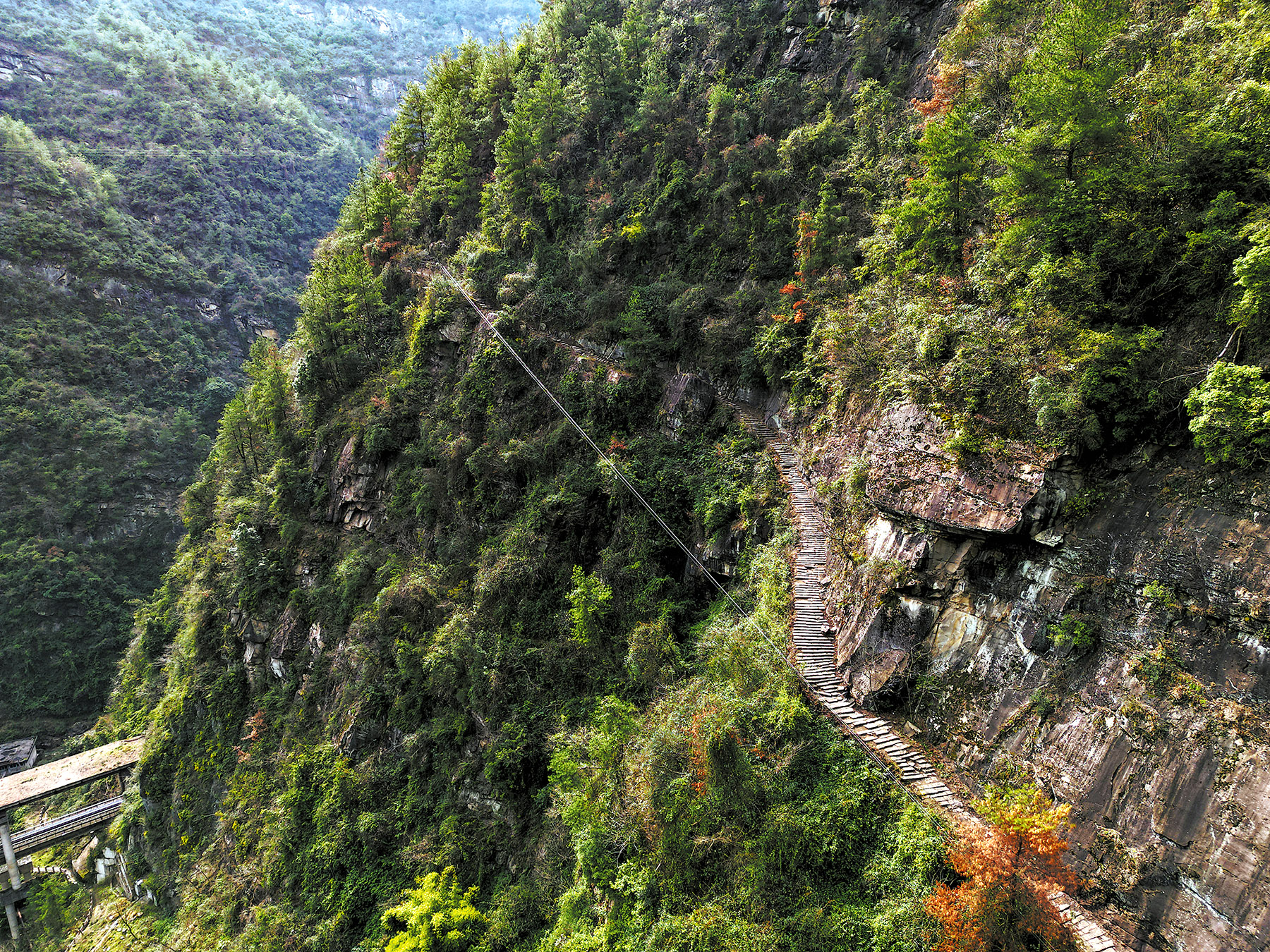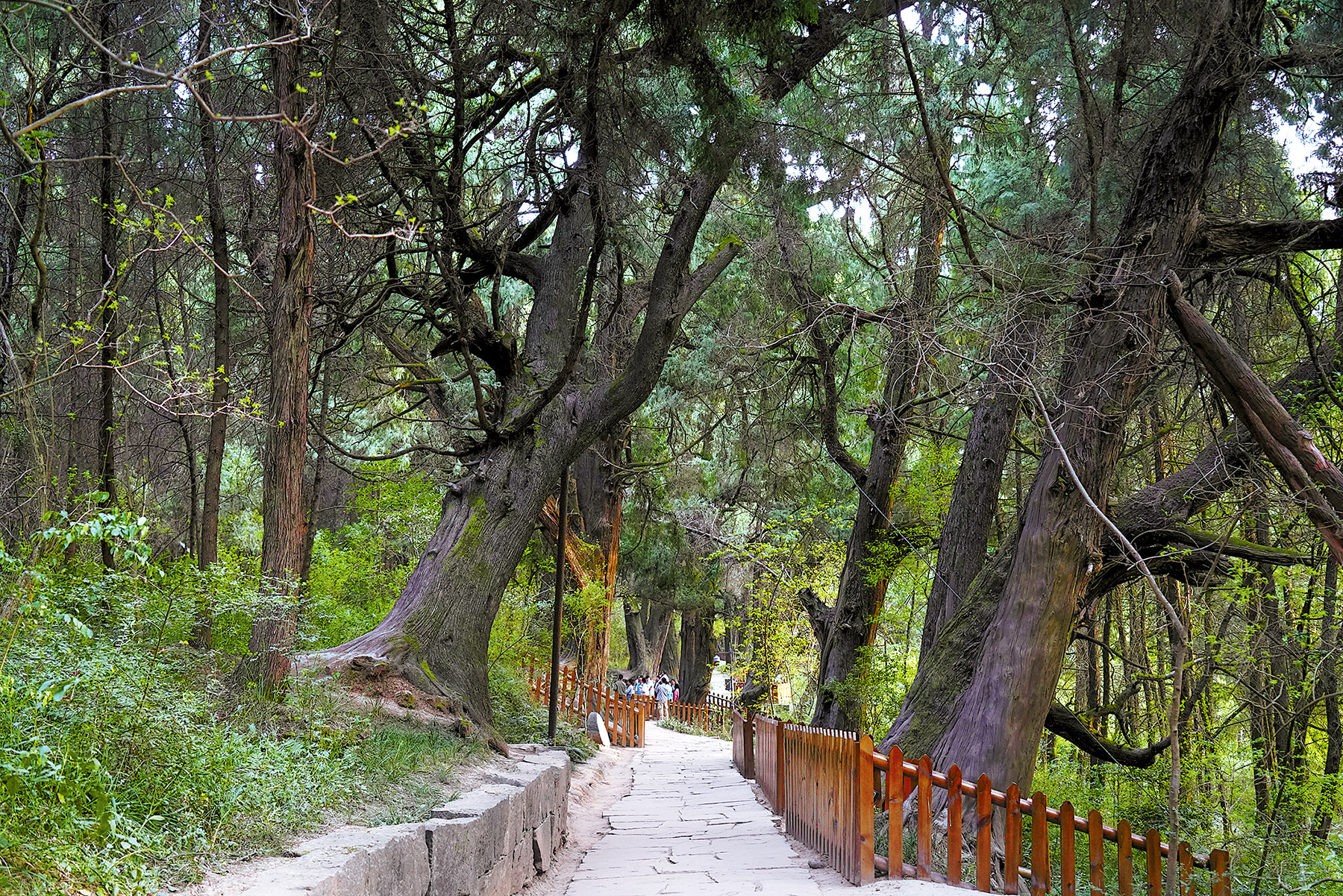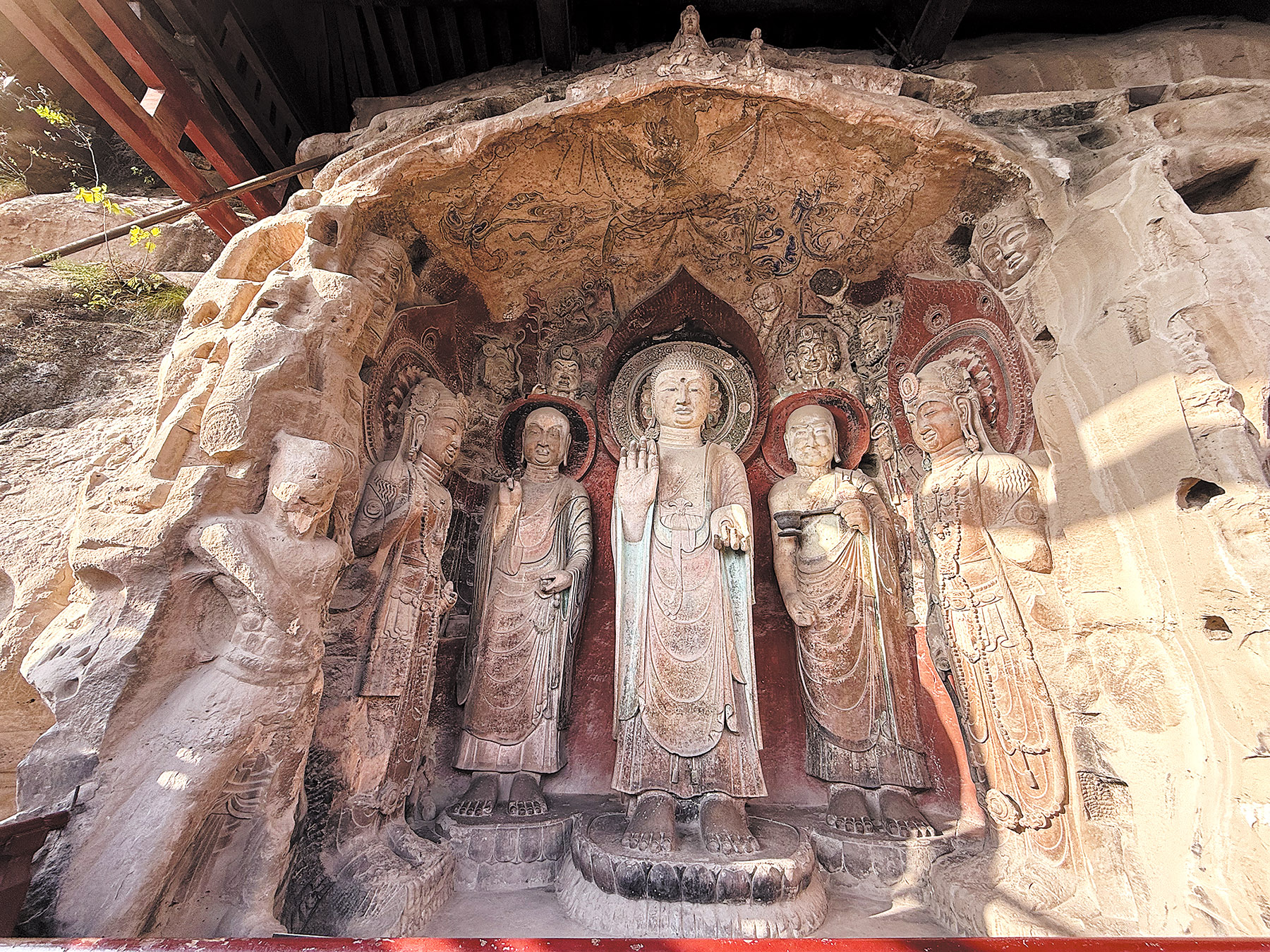Research reveals Shudao network's role in connecting people from different areas, cultures

Winding through mist-covered mountains and flourishing forests, ancient stone steps cling defiantly to cliffs.
Weathered planks and chiseled paths are witness to old tales of merchants, warriors, travelers and rulers of dynasties whose ambitions forged this ancient construction marvel.
This is Shudao, or "Roads to Shu". Shu is a historical term roughly referring to present-day Sichuan province. The ancient road network spreads from the heart of the Sichuan Basin all the way to the Central China Plains. It is more than 2,000 years old, and played a pivotal role in providing transportation arteries throughout ancient China.
The Tang Dynasty (618-907) poet Li Bai, who grew up in Sichuan, wrote in a famous stanza: "The road to Shu is harder than climbing to the blue heavens."
READ MORE: A journey to the west
In July 2023, President Xi Jinping visited Cuiyun Corridor, a section of Shudao in Jiange county, Guangyuan. The corridor is also home to a well-preserved ancient artificial cypress forest in which the oldest tree dates back over 2,300 years. Xi praised the protection efforts that had been made, and urged local authorities to preserve the ancient trees and pass on China's fine traditional culture.
The difficulty of trekking these passageways may have waned thanks to modern transportation, but a new generation of custodians and researchers has set off to revitalize interest in the ancient roads.

Path to understanding
At a temple in Jiange county, Fu Yubin and his team carefully measure an 800-year-old stone tablet while studying the blurred inscriptions.
It records how a magistrate during the Southern Song period (1127-1279) organized locals to maintain the roads and plant trees along them, an indication that environmental awareness existed centuries ago.
The team, from the county's cultural relics protection and management office, is part of the ongoing fourth national census on cultural relics being conducted across China.
Trekking remote mountains and forests, its six members have verified and registered 30 new cultural relics from 120 reported across the county. Over 30 potential new discoveries are also waiting for final evaluation.
The team has also erected protection signs for newly discovered cultural heritage items and assigned custodians to ensure their safety.
"The locals are very welcoming," Fu said. "A villager once guided us deep into the wilderness. We traversed the remote terrain for more than an hour, using a machete to clear dense vegetation before locating a hidden inscribed stone tablet."
READ MORE: Xi emphasizes culture, ecology during visits
As a participant in the third national census on cultural relics in China from 2007 to 2011, Fu has seen great changes in the field.
"Gone are the days of relying solely on measuring tapes. Now, digital devices record relic dimensions with greater accuracy. We also have advanced tools like drones to capture detailed site photos from above," he said.
The current mechanism establishes a scientific framework and clearly delineates responsibilities among departments.
Fu said the fourth census will improve understanding of the cultural heritage associated with ancient roads. "We've carefully studied the stories behind each tablet inscription, stone monument and ancient building, thereby enriching understanding of our cultural heritage resources," he said.
He has also noticed the government now pays much more attention to cultural heritage conservation, stressing the importance of uncovering the historical value of relics and bringing them to life. As a result, public awareness of relics preservation has greatly improved.
"The spirit of the ancient roads, forged through millennia, embodies the unyielding resilience of our ancestors who carved pathways through mountains while working in harmony with the rugged landscape," said Cai Dongzhou, a professor at the School of History and Culture, China West Normal University, in Nanchong, Sichuan.
"This legacy of perseverance and adaptive ingenuity continues to inspire generations," he said.
"Its ecological value also benefits us greatly," Cai added. "In Cuiyun Corridor, for example, both (various) governments and the general public have actively planted and protected the ancient cypress trees for generations. It's also a typical example of eco-friendly civilization."

Archaeological horizons
In March 2024, a large-scale archaeological project focusing on Shudao was launched following the fourth national census. The project not only covers Sichuan, but also extends to nearby Chongqing municipality as well as Shaanxi and Gansu provinces.
Archaeological research institutes from the four provincial-level regions joined hands to establish a uniformed format for research for the project.
For example, the archaeologists focus on a 50-meter zone on both sides of a route to collect information and relics, and criteria have been standardized to classify the findings.
"This could set a national example for research of ancient road ruins and the lineage of cultural heritage sites," said Zheng Wanquan, an associate researcher at the Sichuan Provincial Institute of Cultural Relics and Archaeology who co-hosted the project.
By April this year, sections of Shudao totaling 2,073 km, and 1,034 heritage sites along its routes — including plank road ruins, bridges, and temples — had been investigated. Among them, 297 sites were newly found.
Many names of the sections are connected to famous stories in Chinese history.
On Chencang route, Liu Bang, the founding emperor of the Han Dynasty (206 BC to AD 220) confused his adversary and mobilized a mighty army.
Qishan route was where the renowned 3rd-century strategist Zhuge Liang regretted his failed expeditions and unfulfilled ambitions to unite the nation.
On Lizhi route, galloping horses carried gifts of lychees from Tang Dynasty emperor Li Longji to a beloved concubine, giving the road its name, as lizhi means lychee.
Also, inscriptions on tablets tell how local governments and residents built and managed the roads and the roles played by many unsung heroes.
"We compare plank roads and bridges in various forms on different sections," Zheng said. "They fully demonstrate the complexity of Shudao and how the builders throughout history showed their creativity and craftsmanship in construction."
Studies of the heritage sites and written records, including chronicles, literature, and other documentation, may help portray everyday life along the rugged routes.
Rich documentation on Shudao and its ruins exists for the periods after the Qin (221 to 206 BC) and Han dynasties, Zheng said. Back then, rulers of powerful, united central dynasties in China had begun to build roads connecting Sichuan with the rest of the country.
"We can use the heritage of the roads to link the scattered dots," he said. "However, before that period, clear historical recordings are insufficient. We mainly refer to excavations and look for clues from under the ground. The dotted discoveries will join into lines and thus point where the roads went."
Shudao roads might have originally been regional roads, that later became part of a national road network.
Li Yanfeng, an associate researcher at the Shaanxi Academy of Archaeology, led a team to unearth a surprise discovery at the Liangluping site near the Chencang route in Baoji, Shaanxi.
Excavated tombs and pottery at the site indicate they are over 3,000 years, and existed before the Western Zhou Dynasty (c. 11th century to 771 BC) was established to rule a vast territory centered on Shaanxi.
"Thanks to roads over the mountains, Zhou people were found to have settled in the river valley (to the south)," Li said. "We also discovered relics from various historical periods on the site, which proved the crucial role the road played in south-north communication."

Exchange routes
On the northern edge of the Sichuan Basin, the Qinling Mountains shield fertile land from cold southerly winds and are also a physical boundary between northern and southern China.
However, due to the ancient roads, people on both sides of the mountains were not separated.
Sun Hua, an archaeology professor at Peking University, said recent research showed many city ruins were found along Shudao's routes in different provinces, indicating its function as a network of national roads.
"Temples show how Buddhist art spread into Sichuan and boomed there. Porcelain produced in Sichuan has been found along the routes," Sun said. "Shudao was not only a complex of passageways with political and military significance, it created hubs for wide cultural and economic links."
ALSO READ: Ancient trees treasured in Chongqing
Cai, the history professor, said the ancient roads enabled economic trade, administrative governance and national unity.
"China has had many mass migrations in its history, and the roads promoted ethnic integration and boosted cultural exchanges between the southern and northern regions," Cai said.
Veteran archaeologist Wang Zijin, a professor emeritus at Renmin University of China, said Shudao has global significance.
"Key ancient civilizations around the world often formed and prospered along big rivers," Wang said. "In China, it also happened along the Yellow and Yangtze rivers. But ancient Chinese people overcame the geographic barriers between the basins of the two big rivers to form a unity. That's something extraordinary.
"Road networks extending from Shudao, the Silk Road as well as the Maritime Silk Road were also connected. That left an outstanding mark on the world's history," he said.
Contact the writers at wangkaihao@chinadaily.com.cn


